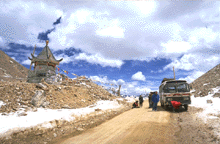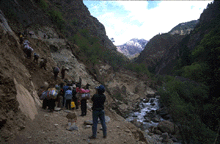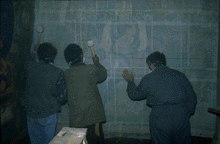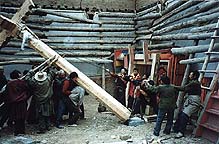click on small images to view full screen with
caption
go to the bottom of the page to see a March '97 photo from Baiya
 |
| Expedition bus stops at Qiao'er Shan on the way to Dege. |
Bang, bang, bang! A team of three strong men is using wooden hammers to pound a painted image of Sakyamuni. It crosses my mind that beating the founder of Buddhism might be breaking an ecclesiastical law, so I glance at Lama Tenzing, who is in charge of this Tibetan monastery, to see if he disapproves. To my relief, Tenzeng looks impassive, and so the pounding goes on. Soon the mural, which has been covered with layers of fixative, gauze and glue, is hanging free from the wall. The men roll up the painting; then they carry it outside where it sees daylight for the first time in its 270 years.
This is my fifth visit to Baiya Monastery, and by now Lama Tenzing trusts that my team is only trying to preserve Tibetan architecture and art. On this expedition I brought three Italian experts with me to detach Baiya's murals from its collapsing clay walls. One of the experts is Guido Botticelli, Italy's foremost authority on detaching wall paintings. Thanks to his experience and that of his two companions, Carlo Giantomassi and Donatella Zari, that this work can take place.
 |
| Damage to a trail means that the expedition equipment must be carried up this hill of dirt to where the horses are waiting to take the team to Baiya. |
It hasn't been easy. First, there was the journey. My team of foreign experts, Tibetan apprentices, and support staff reached Baiya only after four days by car, then half a day in a caravan thirty-one horses long. Since we started work the expedition has been plagued by lost and defective materials, moreover the cold, rainy weather is hardly conducive to glue-drying. Yet Guido and the other two experts have overcome all the problems, and after much trial and error have decided that pounding the painting is the surest way to separate the mural from its underlying clay.
Baiya Monastery's murals are one of the few surviving examples of the Dege style of painting, Dege being an ancient enclave that once ruled twenty-five tribes on the eastern plateau. Now Dege County is the center of a Buddhist art revival, yet today's young painters cannot match the skill of their ancient predecessors. To ensure that Baiya's sublime images survive to inspire and instruct future generations is the purpose of this CERS project.
 |
| The team loosens a mural from its underlying clay by hitting the gauze-covered mural with mallets. |
Now, in our rustic mess hall in another part of the monastery, the patient lies flat upon the table. The surgeons--Guido and his two assistants--carefully attach a new lining to the back. Then comes the final, crucial step. They daub the front of the painting with hot water to dissolve the glue, then peel away the layers of gauze to expose the paint beheath. Slowly, the graceful form emerges, like a shapely youth stepping out of a steamy shower.
Throughout the conservation procedure, our four Tibetan conservation apprentices have been assisting the experts. The best of them, Deshi Yangjin, who joined our program last year, is already able to undertake cleaning jobs on her own.
This year's expedition is nearly over, but the job is not finished; for Baiya Monastery's damaged walls, rotten timber, and leaking roof must be repaired. Then comes another expedition to re-mount the murals. I look forward to seeing a reborn Baiya Monastery.
 |
| The most recent photo from Baiya. |
9/1/97 from the editor: Pamela Logan recently sent Asian Arts this photo of
renovation work at Baiya, " It shows the main temple interior, lit by daylight
because the roof has been taken off. Workers are hoisting one of the new columns. The
murals are covered and so not visible. It was taken in March or so of this year
(1997)."